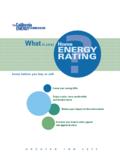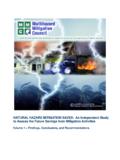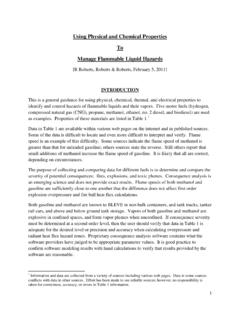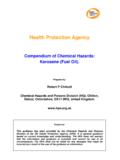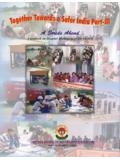Transcription of LESSON PLAN - generationgenius.com
1 SUMMARYS tudents explore the science of natural disasters by learning how natural hazards impact organisms (including humans) and the environment . They also learn about the role of engineering design in protecting people from natural hazards . CORRELATION4-ESS3-2 Generate and compare multiple solutions to reduce the impact of natural Earth processes on humans. 2018 1 LESSON PLANNATURAL DISASTERSGRADES 3-5 Disciplinary Core IdeasConnections to Classroom natural hazards A variety of hazards result from natural processes ( , earthquakes, tsunamis, volcanic eruptions). Humans cannot eliminate the hazards but can take steps to reduce their impacts.
2 (4-ESS3-2) : Developing Possible Solutions Testing a solution involves investigating how well it performs under a range of likely conditions. Describe the science behind the formation of earthquakes, volcanoes, and tsunamis and the solutions used to help mitigate their impact on humans. Test the effectiveness of different engineering designs used to protect people from volcanoes and earthquakes. Science & Engineering PracticesConstructing Explanations and Designing Solutions (4-ESS3-2) Design a seismograph and use it to study the strength of a simulated earthquake. Connections to Classroom Activity Science notebooks PencilsStation 1 Wooden blocks Lego blocks Cookie sheet Station 2 Tray that can hold water Water Sand Plastic objects ( trees, people, houses) Small ball Large ball Station 3 Yogurt Graham crackers Paper plates Spoon DIY Activity Box Scissors Rubber bands Marker Paper strip Ruler Cellphone or tablet MATERIALSDURATIONOne to two 45-minute classroom periods PRE-ASSESSMENT QUESTIONSP lease see Discussion Questions located under the video.
3 These can be discussed as a group or answered individually in student science notebooks. ENGAGEShow students a small cardboard box and a metal box. Ask students to describe what they see. Have them identify which box would most likely withstand an earthquake and ask students to explain why. Next, as a class discussion, have students state the different types of natural disasters they know of. Explain that scientists study natural disasters to help keep people safe simply because they cannot be eliminated. Also mention that engineers construct buildings and design solutions to protect people during natural disasters. 2 2018 ConceptsConnections to Classroom ActivityCause and Effect (4-ESS3-2) Understand what causes natural hazards and the effect they have on people to evaluate the different engineering designs used to protect people from harm.
4 EXPLOREE xplain to students that they will explore three different types of natural disasters volcanoes, earthquakes, and tsunamis. They will learn about the cause of each natural disaster and how humans are working to reduce the impact from these disasters. Specifically, students will discover how to test the effectiveness of different engineering designs created to protect people from natural disasters. Set up the following stations around the room:STATION 1: SHAKY GROUNDB uild a small tower using wooden blocks and place this on a cookie sheet. Build another tower, similar in size, using Lego blocks. Place this on the same cookie sheet. Have students shake the cookie sheet and make observations about what happens.
5 STATION 2: THE TSUNAMI EFFECTFill a long tray with water and add sand, which will function as the land near the water. Add in objects, such as toy people or trees, to the area of land. Have students drop a small ball in the water and observe what happens to the water and objects. Then have students drop a much larger ball in the water and observe what happens. STATION 3: SHIFTING OF THE CONTINENTS Prepare four paper plates with a thin layer of yogurt. There should be enough to move two halves of graham crackers past and on top of one another. When students are ready, use 2 halves of a graham cracker to represent continents. Students should push them into one another, causing them to slide by one another, or go over and on top of one another.
6 (Yogurt can be dyed red to look like magma.)STATION 4: VOLCANIC ERUPTION Have students describe what impact eruptions may have on organisms (including humans) and the environment they live in. Ask students to think of one solution to protect these organisms from the effects of a volcano eruption. Divide students into four groups. Allow the groups to rotate through each station, using their science notebooks to record their observations. 2018 3 STATION 1 WHAT HAPPENED WHEN YOU SHOOK THE COOKIE SHEET? Shake the cookie sheet with the wooden blocks and observe what you see. Then shake the cookie sheet with the Lego blocks and observe what you see. Write your observations in your notebook and explain why things happened the way they 2 WHAT HAPPENS TO THE LAND AND OBJECTS WHEN A SMALL BALL IS USED INSTEAD OF THE LARGE BALL?
7 Use this model of tsunamis to think about the damage these natural disasters can cause when they make their way on land. After dropping both balls in the water, write down your observations in the notebook. Include why you think the end result happened the way it 3 WHAT HAPPENS AS CONTINENTAL PLATES COLLIDE AND SEPARATE?Gently push your graham cracker continents into one another. As they collide and separate what happens? Write your answer in the notebook. As you study this model think about what natural formations could be made by this process?STATION 4 WHY ARE VOLCANOES SO DANGEROUS? What are some of the dangers surrounding a volcanic eruption? What are some effects this could have on the plants, animals and people?
8 How can we protect these organisms from volcanic eruptions? Discuss and write down your answers to these questions in your 2018 EVALUATER evisit the discussion about what type of buildings can withstand an earthquake, as demonstrated in the Engage portion of the activity. Students have learned a lot about the science of natural disasters, specifically, volcanoes, earthquakes, and tsunamis. They are also familiar with the different engineering technologies used to reduce the impact from these natural disasters. Ask students to describe how they would redesign these models used in the demonstration to make them more resistant against earthquakes.
9 Next Generation Science Standards is a registered trademark of Achieve, Inc. A non-profit dedicated to raising academic standards and graduation plan written by Mountain Goat Instructional Design. EXPLAINA fter all groups have completed all four stations, gather the students to begin a class discussion about natural disasters and the dangers they pose to organisms and the environment . Discuss that station 1 illustrated how engineering is used to solve the problem of protecting people when earthquakes happen. Station 2 presented a model to show just how dangerous the waves of tsunamis are. Station 3 demonstrated the role plate boundaries play in causing earthquakes, subduction, creating volcanoes, and forming mountains.
10 Station 4 provided an opportunity for students to discuss what happens to organisms and the environment when volcanoes THE GENERATION GENIUS natural DISASTERS VIDEO AS A CLASS ELABORATES tudents can use the DIY activity to make their own homemade seismograph just like Zoe did on the video. They should be able to explain the purpose of using a seismograph as well as how one is constructed. Encourage students to explain the patterns they see after using their seismograph with a simulated earthquake. They should be able to recognize that the patterns provide information about the magnitude of an earthquake.
![Natural Disasters | 5E Lesson Plan for Grades 3-5 [PDF]](/cache/preview/8/0/9/c/e/7/2/f/thumb-809ce72f931e610fe94c698182f94da5.jpg)
![What is Science? | 5E Lesson Plan for Grades K-2 [PDF]](/cache/preview/7/4/e/4/1/3/6/3/thumb-74e41363994c2eb466bf861bbe860774.jpg)
![Weathering & Erosion | 5E Lesson Plan for Grades 3-5 [PDF]](/cache/preview/f/0/5/2/c/e/5/b/thumb-f052ce5b2e69fc2ea580a59cb704d9d6.jpg)
![Living vs. Non-Living | 5E Lesson Plan for Grades K-2 [PDF]](/cache/preview/1/5/0/5/c/1/5/2/thumb-1505c15273daf157385e9717a453fa28.jpg)
![Ecosystems | 5E Lesson Plan for Grades 3-5 [PDF]](/cache/preview/3/7/3/5/6/2/e/1/thumb-373562e11bfd5c636d56d01f227d09a5.jpg)

![Sun & Stars | 5E Lesson Plan for Grades 3-5 [PDF]](/cache/preview/3/8/9/6/7/a/2/9/thumb-38967a29ac1fe92fba7fa7d775945b90.jpg)

![Human Body Systems | 5E Lesson Plan for Grades 3-5 [PDF]](/cache/preview/5/3/7/d/5/f/0/a/thumb-537d5f0a980c7ec9133056914a11eb75.jpg)
![Weather vs. Climate | 5E Lesson Plan for Grades 3-5 [PDF]](/cache/preview/d/7/c/0/6/c/d/6/thumb-d7c06cd6fdf48a1bc04b4f1b0e7e23b6.jpg)
